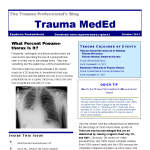Everybody remembers Boyle’s law, right?
Volume of a gas = k / Pressure (where K is a constant)
Which means that, as pressure goes down, the volume of a gas increases. This is important for patients who have a pneumothorax and get on an airplane. As the plane ascends the pneumothorax gets bigger and they may have serious problems. Click here to see guidelines on flying after pneumothorax.
Well, what happens if you have air bubbles in your head (pneumocephalus)? Some patients with serious head injury may have this condition but need to be transported by air to definitive care. Most recently, this has been a consideration in military medical evacuation flights out of Afghanistan.
A paper from the US Army and Air Force studied 21 soldiers (small series) who were evacuated by air with known pneumocephalus. The volume of air was estimated by CT prior to transport, and ranged from less than 1ml to 43ml. None of the patients suffered neurologic deterioration during flight, and 3 who had external ventricular drainage (EVD) showed no significant change in intracranial pressure.
Bottom line: Only two cases of tension pneumocephalus have ever been described. Neither occurred in trauma patients. While expanding pneumothorax may be a problem during commercial flight, there is still little data on tension pneumocephalus. It works for the military because the soldiers are in a flying ICU and can be treated immediately if a problem develops. Not so in commercial aircraft, so beware! But remember, medical helicopters don’t fly high enough to create tension problems in any part of the body, so they are not an issue.
Related posts:
Reference: Aeromedical evacuation of patients with pneumocephalus: outcomes in 21 cases. Aviation Space Env Med 79(1):30-35, 2008.


